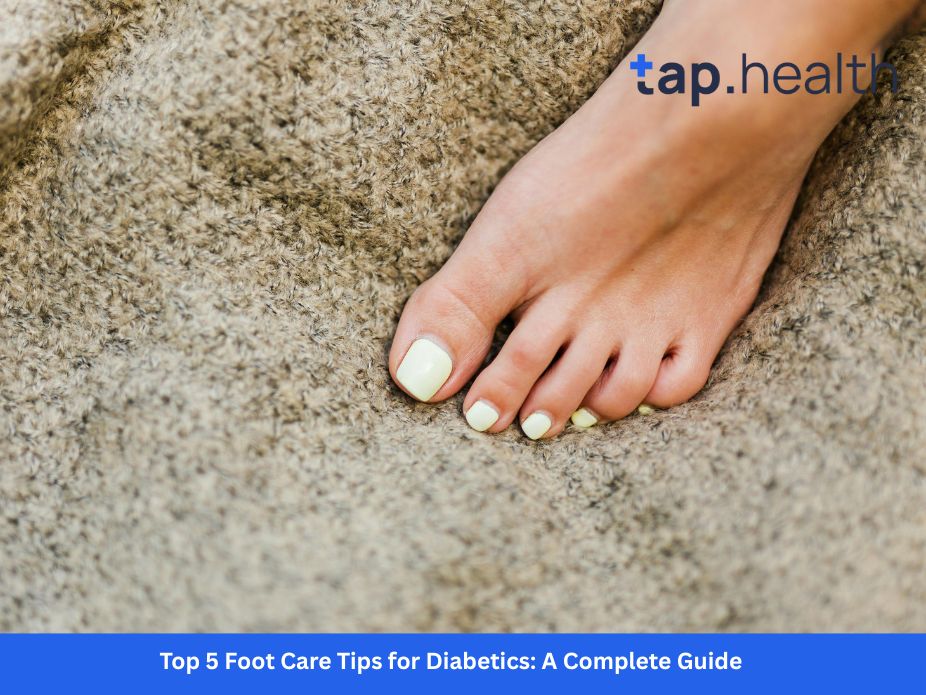Foot care is one of the most important aspects of diabetes management. High blood sugar levels can damage the nerves and blood vessels in your feet, leading to serious complications like infections, sores, and even amputations. Proper foot care can help prevent these issues and keep your feet healthy. In this complete guide, we will explore the top 5 foot care tips every diabetic should follow to maintain healthy feet and reduce the risk of foot-related complications.
Why Foot Care is Crucial for Diabetics
People with diabetes are at a higher risk of foot problems because high blood sugar can damage nerves (neuropathy) and blood vessels (poor circulation). This makes it harder to feel injuries like cuts or blisters, and the reduced blood flow can make it difficult for your body to heal wounds. Because of these factors, diabetes can lead to severe foot complications if not managed properly.
Foot complications in diabetics can include:
- Nerve damage (peripheral neuropathy)
- Poor circulation (peripheral artery disease)
- Foot ulcers or sores that don’t heal
- Infections that can become severe
- Risk of amputations if untreated
Taking good care of your feet can help prevent these serious issues. Now, let’s look at the Top 5 Foot Care Tips for Diabetics that every diabetic should follow.
Top 5 Foot Care Tips for Diabetics
1. Keep Your Feet Clean and Dry
Daily Foot Washing
The first and most important step in foot care for diabetics is keeping your feet clean. Wash your feet daily with warm water and mild soap. Avoid using hot water, as it can dry out your skin and cause burns, especially if you have reduced sensation in your feet due to nerve damage.
When washing your feet:
- Use lukewarm water, not hot, to prevent burns.
- Gently wash your feet with a mild soap, ensuring to clean between the toes.
- Do not soak your feet for long periods, as it can dry out the skin and lead to cracks.
Dry Your Feet Thoroughly
After washing, carefully dry your feet, especially between the toes. Moisture can lead to fungal infections like athlete’s foot. Pat your feet dry with a soft towel, making sure to dry the spaces between the toes thoroughly. You can also apply a moisturizing lotion to keep your skin soft and prevent dryness, but avoid putting lotion between the toes to prevent fungal infections.
2. Inspect Your Feet Regularly
Check for Cuts, Sores, or Blisters
Diabetics should check their feet daily for any signs of injury or infection. Since high blood sugar can reduce sensation in your feet, you may not feel a small cut, blister, or scratch. However, if left untreated, these small wounds can become severe infections.
When inspecting your feet:
- Look for cuts, blisters, redness, swelling, or calluses.
- Check for any changes in the color or temperature of your feet.
- Pay attention to any cracks in the skin or areas where your shoes might rub.
If you notice anything unusual, seek medical attention right away. Early detection of foot problems is key to preventing complications.
3. Wear Proper Footwear
Choose Comfortable and Well-Fitting Shoes
Wearing the right shoes is essential for foot care. Ill-fitting shoes can cause blisters, sores, and calluses, all of which can lead to infection if not treated. For diabetics, it’s crucial to wear shoes that provide enough space, cushioning, and support for your feet.
When choosing shoes:
- Opt for shoes with a wide toe box to prevent pressure on the toes.
- Make sure the shoes have soft insoles and adequate arch support.
- Avoid high heels or shoes with pointed toes, as they can cause pressure on your feet.
- Look for shoes made from breathable materials to reduce sweating and keep your feet dry.
- Consider orthopedic or diabetic-friendly shoes designed specifically for foot health.
Protect Your Feet with Socks
In addition to wearing the right shoes, choose socks that provide comfort and protection. Avoid socks with tight elastic bands or seams that can cause irritation. It’s best to wear socks made from natural fibers like cotton or moisture-wicking fabrics that help keep your feet dry.
If you have diabetes, consider wearing socks designed for diabetic feet. These socks are typically made from soft, seamless materials and feature a loose, non-binding fit to reduce pressure and improve circulation.
4. Trim Your Toenails Carefully
Proper Toenail Care
Trimming your toenails regularly is important for preventing painful ingrown nails, which can lead to infection. However, improper toenail trimming can cause injury, especially if you have reduced sensation in your feet.
Here’s how to trim your toenails safely:
- Use a clean, sharp nail clipper to trim your toenails straight across.
- Do not cut the nails too short, as this can cause painful ingrown toenails.
- Avoid cutting or digging into the corners of the nails.
- If you can’t trim your nails properly, consider seeking help from a podiatrist to avoid injury.
If you have thickened toenails, it’s a good idea to visit a podiatrist for professional nail care to prevent problems.
5. Maintain Healthy Blood Sugar Levels
Control Your Blood Sugar to Prevent Foot Problems
Maintaining good blood sugar control is crucial for diabetic foot care. High blood sugar can damage nerves and blood vessels, leading to poor circulation and loss of sensation in your feet. By keeping your blood sugar levels within a healthy range, you can prevent long-term complications that affect your feet.
Tips for maintaining healthy blood sugar levels:
- Follow a balanced diet with plenty of vegetables, lean proteins, and whole grains.
- Monitor your blood sugar levels regularly and take medications as prescribed by your healthcare provider.
- Exercise regularly to help improve insulin sensitivity and circulation.
- Stay hydrated and avoid excessive consumption of sugary foods and drinks.
Frequently Asked Questions (FAQs)
1. How can I prevent foot problems as a diabetic?
Preventing foot problems as a diabetic starts with daily foot inspections, keeping your feet clean and dry, wearing well-fitting shoes, and regularly trimming your toenails. Managing your blood sugar levels and seeking prompt medical attention for any issues are also essential for maintaining healthy feet.
2. What type of shoes are best for diabetics?
Diabetic-friendly shoes should have a wide toe box, cushioning, good arch support, and soft insoles. Look for shoes made from breathable materials and avoid tight-fitting or high-heeled shoes. Special diabetic shoes and insoles can be purchased for added comfort and foot protection.
3. How often should I check my feet if I have diabetes?
It’s recommended to check your feet daily for any signs of cuts, blisters, redness, or other changes. This is especially important for people with diabetic neuropathy, which can reduce sensation in the feet, making it easier to overlook minor injuries.
4. Can diabetic foot problems be reversed?
While some diabetic foot problems can be managed or treated, nerve damage and circulation issues may not be fully reversible. However, early detection and proper foot care can help prevent serious complications like infections and amputations. Regular visits to a healthcare provider can help catch problems before they become severe.
5. Is it safe to soak my feet if I have diabetes?
Soaking your feet for long periods can dry out the skin and increase the risk of infection. It’s best to wash your feet with lukewarm water and mild soap, and then dry them thoroughly. Avoid soaking your feet, especially if you have poor circulation or diabetic neuropathy.
By following these Top 5 Foot Care Tips for Diabetics, you can help protect your feet from complications and keep them healthy for years to come. Remember, diabetes doesn’t have to result in foot problems if you take the right precautions. With regular foot care, proper footwear, and maintaining healthy blood sugar levels, you can enjoy a higher quality of life and prevent serious foot issues.



